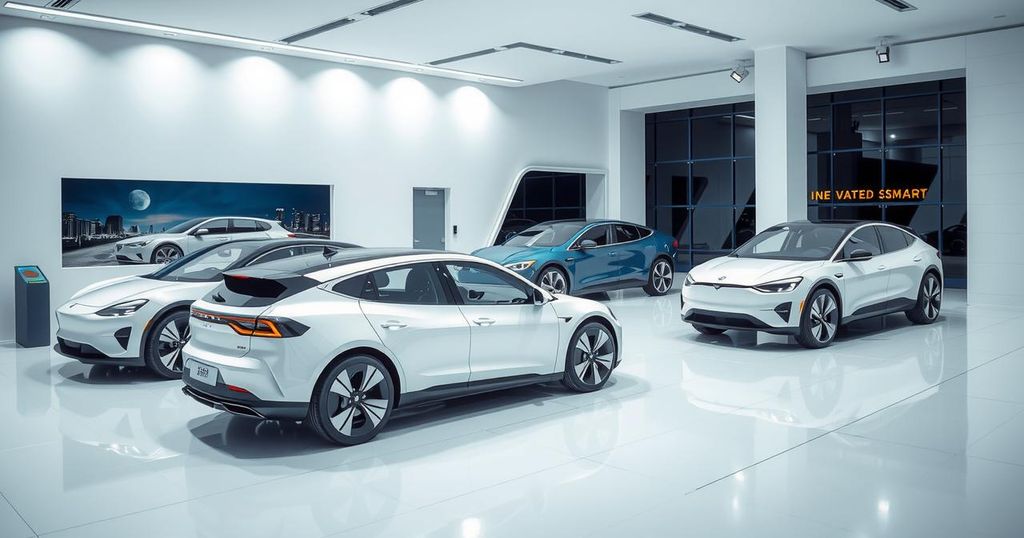Key Moments From President Trump’s Rapid Middle East Tour
President Trump’s recent Middle East trip emphasized major deals aimed at redefining U.S. relations with the region, including a $142 billion arms agreement in Saudi Arabia, controversial talks on Gaza, and discussions for a new Iran nuclear deal. His interactions with leaders reflect ambitious diplomatic goals and significant investment agreements that may set the tone for future U.S. policy in the area.
President Donald Trump has wrapped up a whirlwind tour across the Middle East, making significant statements aimed at reshaping U.S. relations in the region. Trump’s journey included investment agreements, a first meeting with a Syrian President in over two decades, and the potential rekindling of negotiations for a nuclear deal with Iran. This trip seems pivotal for future diplomatic dynamics.
Kicking off his trip on May 13 in Riyadh, Saudi Arabia, the President was warmly received. Trump signed multiple agreements totaling billions, covering various industries. Notably, a $142 billion arms deal was inked, projecting U.S. support and commitment to Saudi Arabia, while also enhancing security ties.
Next, Trump headed to Qatar’s capital, Doha, on May 14. There, he secured an impressive $96 billion deal with Boeing and engaged business leaders, reviving an earlier notion regarding a U.S. takeover of the Gaza strip. This assertion raised eyebrows, hinting at a controversial stance on the ongoing Israeli-Palestinian conflict.
Arriving in the United Arab Emirates on May 15, the President concluded his tour by signing a groundbreaking deal focusing on artificial intelligence, valued at approximately $1.4 trillion. Such steps signal a progressive era in U.S. policy towards technology and collaboration in the region.
Reflecting on accomplishments from the trip, Trump mused, “Somebody’s going to be taking the credit for this. You remember, press, this guy did it,” during a return flight on Air Force One. It’s clear that he feels that future administrations may benefit from the groundwork laid during his travels.
Trump’s proposal to lift U.S. sanctions on Syria—some in place for over 45 years—was a surprising announcement made at the U.S.-Saudi Investment Forum in Riyadh. He described the sanctions as “brutal and crippling” yet previously necessary for stabilizing the region. Experts have noted that following through with this plan will be complex, entailing an intricate re-evaluation of existing policies.
During the visit, Trump met with Syrian President Ahmed al-Sharaa, alongside the Saudi Crown Prince and Turkish President Erdogan via phone. Trump characterized al-Sharaa as a tough leader with the potential to unite Syria. The President urged him to normalize ties with Israel and diminish terrorism within Syria.
The decision to accept a luxury Boeing valued at $400 million, gifted by Qatar, ignited controversy prior to his trip. Concerns over ethics and national security were raised. Critics warned that accepting such a gift could necessitate congressional oversight. Trump, however, remains resolute, asserting that the plane will benefit the U.S. Air Force, saying, “Only a FOOL would not accept this gift on behalf of our country.”
Trump brought attention to Gaza, suggesting that the U.S. should establish a “freedom zone” there. He expressed a desire to see better living conditions for Palestinians, while also addressing widespread destruction in Gaza. His remarks echoed a long-standing issue which remains sensitive and contentious on the world stage.
Discussions around a new nuclear deal with Iran were also a focal point during the tour. Trump declared his intent to negotiate, drawing off the previous deal made under the Obama administration. In remarks to reporters, he emphasized that any deal hinges on Iran curtailing its support for terrorism and halting nuclear armament.
As Trump’s Middle East tour concludes, the implications of his actions could reverberate in U.S. foreign policy for years to come. This series of high-stakes negotiations and agreements reflects a multifaceted approach to the region, though many complexities likely await.
In summary, Trump’s Middle East visit encompassed significant agreements in arms, business, technology, and national policies. He urged investment and stability while navigating difficult diplomatic waters. As the situation evolves, the ramifications of these encounters will be closely monitored.
In closing, President Trump’s tour of the Middle East was marked by several significant agreements and controversial proposals. From solidifying arms deals in Saudi Arabia to hinting at lifting sanctions on Syria and discussing a potential takeover of Gaza, each moment carries implications. His discussion with Iran about a nuclear deal remains critical, showcasing the continuous complex dynamics of U.S. involvement in the region. The outcomes of these engagements will undoubtedly shape future diplomatic relations and strategies.
Original Source: time.com




Post Comment